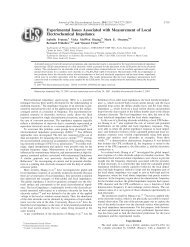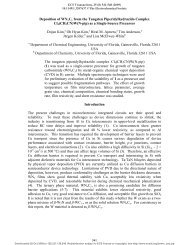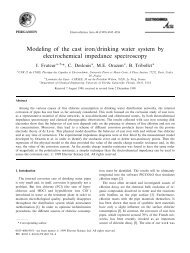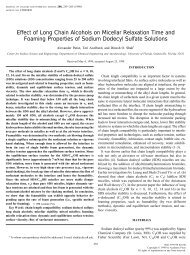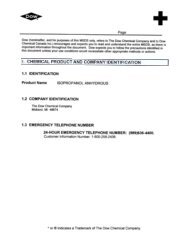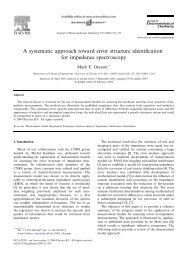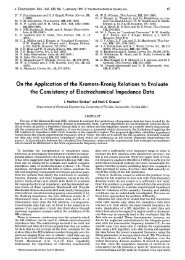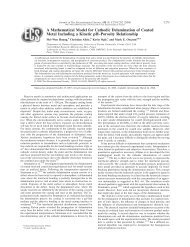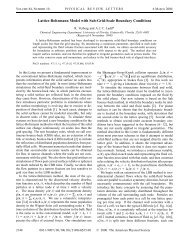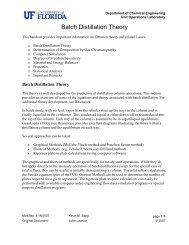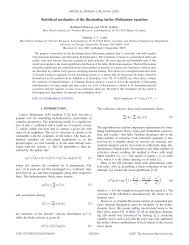Measurement Models for Electrochemical Impedance Spectroscopy ...
Measurement Models for Electrochemical Impedance Spectroscopy ...
Measurement Models for Electrochemical Impedance Spectroscopy ...
Create successful ePaper yourself
Turn your PDF publications into a flip-book with our unique Google optimized e-Paper software.
J. Electrochem. Soc., Vol. 142, No. 12, December 1995 9 The <strong>Electrochemical</strong> Society, Inc. 4149REFERENCES1. J. A. Appleby and E. B. Yeager, Energy, 11, 137 (1986).2. E. A. Ticianelli, C. R. Derouin, and S. Srinivasan,J. EIectroanal. Chem., 251, 275 (1988).3. E. A. Ticianelli, C. R. Derouin, A. Redondo, andS. Srinivasan, This Journal, 135, 2209 (1988).4. S. Srinivasan, E. A. Ticianelli, C. R. Derouin, andA. Redondo, J. Power Sources, 22, 359 (1988).5. M. S. Wilson and S. Gottesfeld, J. Appl. Electrochem.,22, 1 (1992).6. M. S. Wilson and S. Gottesfeld, This Journal, 139, L28(1992).7. M. S. Wilson, U. S. Pat. 5,211,984 (1993), 5,234,777(1993).8. M. Uchida, Y. Aoyama, N. Eda, and A. Ohta, This Journal,142, 463 (1995).9. M. Watanabe, M. Tomikawa, and S. Motoo, J. EIectroanal.Chem., 195, 81 (1985).10. M. Watanabe, K. Makita, H. Usami, and S. Motoo, ibid.,197, 195 (1986).11. M. Giordano, E. Passalacqua, V. Recupero, M. Vivaldi,E. J. Taylor, and G. Wilemski, Electrochim. Acta, 35,1411 (1990).12. M. Giordano, E. Passalacqua, V. Alderucci, P. Staiti,L. Pino, H. Mirzaiani, E. J. Taylor, and G. Wilemski,ibid., 36, 1049 (1991).13. D. S. Chan and C. C. Wan, J. Power Sources, 50, 261(1994).14. T. Mort, J. Imahashi, T. Kamo, K. Tamura, and Y. Hishinuma,This Journal, 133, 896 (1986).15. D. S. Cameraon, J. Mol. Catal., 38, 27 (1986).16. A. Pebler, This Journal, 133, 9 (1986).17. K. Mitsuda, H. Shiota, H. Kimura, and T. Murahashi,J. Mater. Sci., 26, 6436 (1991).18. T. Kenjo and K. Kawatsu, Electrochim. Acta, 30, 229(1985).19. T. Maoka, ibid., 33, 379 (1988).20. K. Kordesh, S. Jahangir, and M. Schautz, ibid., 29, 1589(1984).21. R. Holze and J. Ahn, J. Membrane Sci., 73, 87 (1992).22. T. Sakai, H. Takenaka, and E. Torikai, This Journal,133, 88 (1986).23. Y. Aoyama, M. Uchida, N. Eda, and A. Ohta, AbstractIC08, p. 62 of Annual Meeting of The <strong>Electrochemical</strong>Society of Japan, Sendal, 1994.24. Y. Aoyama, M. Uchida, N. Eda, and A. Ohta, Abstract2K03, p. 257 of Fall Meeting of The <strong>Electrochemical</strong>Society of Japan, Tokyo, 1994.25. G. Petrow and R. J. Allen, U.S. Pat. 4,044,193 (1977).26. M. Watanabe, M. Uchida, and S. Motoo, J. Electroanal.Chem., 229, 395 (1987).27. M. Uchida, Y. Aoyama, M. Tanabe, N. Yanagihara,N. Eda, and A. Ohta, This Journal, 142, 2572 (1995).Application of <strong>Measurement</strong> <strong>Models</strong> to<strong>Impedance</strong> <strong>Spectroscopy</strong>II. Determination of the Stochastic Contribution to the Error StructurePankaj Agarwal, *'a Oscar D. Crisalle, and Mark E. Orazem**Department of Chemical Engineering, University of Florida, Gainesville, Florida 32611, USALuis H. Garcia-RubioDepartment of Chemical Engineering, University of South Florida, Tampa, Florida 33620, USAABSTRACTDevelopment of appropriate models <strong>for</strong> the interpretation of impedance spectra in terms of physical properties requires,in addition to insight into the chemistry and physics of the system, an understanding of the measurement errorstructure. The time-varying character of electrochemical systems has prevented experimental determination of thestochastic contribution to the error structure. A method is presented by which the stochastic contribution to the errorstructure can be determined, even <strong>for</strong> systems <strong>for</strong> which successive measurements are not replicate. Although impedancemeasurements are known to be heteroskedastic in frequency (i.e., have standard deviations that are functions of frequency)and time varying over the duration of the experiment, the analysis conducted in the impedance plane suggests that thestandard deviations <strong>for</strong> the real and imaginary parts of the impedance have the same magnitude, even at frequencies atwhich the imaginary part of the impedance asymptotically approaches zero. On this basis, a general model <strong>for</strong> the errorstructure was developed which shows good agreement <strong>for</strong> a broad variety of experimental measurements.This paper is part of a series intended to present the foundation<strong>for</strong> the application of measurement models toimpedance spectroscopy. The basic premise behind thiswork is that determination of measurement characteristicsis an essential aspect of the interpretation of impedancespectra in terms of physical parameters. The influence ofthe error structure on interpretation of impedance spectrais discussed elsewhere <strong>for</strong> various electrochemical andelectronic systems. 1-7 In the previous paper of this series, itwas shown that a measurement model based on Voigt circuitelements can provide a statistically significant fit totypical electrochemical impedance spectra. B Here a methodis demonstrated in which the measurement model is used to* <strong>Electrochemical</strong> Society Student Member.** <strong>Electrochemical</strong> Society Active Member.Present address: Department of Materials, Swiss Federal Instituteof Technology (Lausanne), Lausanne, Switzerland.identify the stochastic component of the frequency-dependenterror structure of impedance data. A preliminarymodel <strong>for</strong> the stochastic component of the error is proposed.The third paper of this series addresses the use of themeasurement model <strong>for</strong> identification of the bias componentof the error structure. ~BackgroundThe objective of impedance measurements is identificationof physical processes or parameter values appropriate<strong>for</strong> a given system. Interpretation of impedance spectra requires,in addition to an adequate deterministic model, athorough understanding of the error structure <strong>for</strong> themeasurement. The concept that the error structure plays animportant role in the interpretation of experimental data iswell established in the scientific literature. I~ While its ap-
4150 J. Electrochem. Soc., Vol. 142, No. 12, December 1995 9 The <strong>Electrochemical</strong> Society, Inc.plication to the interpretation of optical spectra is underdevelopment, knowledge of the error structure has beenshown to allow enhanced interpretation of light scatteringmeasurements in terms of particle size distribution or evenparticle classification, n'~2Identification of the error structure <strong>for</strong> most radiationbasedspectroscopic measurements such as light scatteringcan be accomplished by calculating the standard deviationof replicate measurements. The error analysis approach hasbeen successful <strong>for</strong> light spectroscopy measurements becausethese systems lend themselves to replication and,there<strong>for</strong>e, to the independent identification of the differenterrors that contribute to the total variance of the measurements.In contrast, the stochastic contribution to the errorstructure of electrochemical impedance specfroscopy measurementsgenerally cannot be obtained from the standarddeviation of repeated measurements because even a mildnonstationary behavior introduces a nonnegligible timevaryingbias contribution to the error.The discussion of error structures in impedance spectroscopy,there<strong>for</strong>e, has been limited to a priori predictionsof measurement noise based on instrument noise ~3 and tostandard assumptions concerning the error structure suchas constant or proportional errors. ~4-~6 Zoltowski reports anexperimental assessment of the stochastic noise at selectedfrequencies which showed that the standard deviation ofthe real and imaginary parts of the impedance (and admittance)are correlated. ~7 This result was used to defend theuse of modulus weighting <strong>for</strong> regression of models to experimentaldata. ~749 Attempts to weight regressions by standarddeviations determined from repeated impedancescans (e.g., Ref. 20) have not been successful because thestandard deviation obtained from repeated impedancemeasurements includes both bias and stochastic contributionsto the error structure. Our objective here is topresent a procedure <strong>for</strong> assessing the stochastic contributionto the error structure of impedance measurements andto develop a model <strong>for</strong> the stochastic noise of impedancemeasurements.Knowledge of the error structure is essential in assessingexperimental technique and can play a role in determiningthe influence of instrumental strategies. For example, useof matched filters <strong>for</strong> the input of the frequency responseanalyzer has been proposed to be an appropriate technique<strong>for</strong> reducing the noise in impedance spectra. 2~ While thereduction of the noise in input signal can be readily seen bythe display of an oscilloscope, a method <strong>for</strong> assessing thenoise in the ultimate measurement is essential in decidingwhether the filters contribute to reduction of noise in theimpedance spectra.Knowledge of the error structure is also needed <strong>for</strong> analysisof experimental data. For example, proper weightingduring nonlinear regression of a model to impedance datais necessary to get unbiased parameter estimates. ~~ Aweighted least squares strategy that includes the errors inthe real and imaginary parts of the impedance is given byminimization of(Zr, k - Zr, k) 2 (Zj,k -- Zj,k) 2J= E ~ + ~ -' 2 ' [11k O'r,k O'j,kwhere Zr, k and Zi,k represent the real and imaginary part ofthe data, respectively, the caret signifies the correspondingmodel value, and cry, k and %,~ are the real and imaginary partof the standard deviation at each frequency. The use of thevariance to weight data ensures that data points with "lownoise" content are emphasized and the data points with"high noise" content are de-emphasized. Use of the experimentallydetermined variance <strong>for</strong> weighting has beenshown to increase the amount and quality of the in<strong>for</strong>mationthat can be obtained from impedance measurements3Classification of <strong>Measurement</strong> ErrorsThe residual errors (e~J that arise when a model is regressedto experimental data can be described as beingcomposed of deterministic (systematic) and stochastic(randomly distributed) contributions, Esyst and es~ooh, respectively.Thus, at any given frequencyZ - Z = ere~ = esy~t + e~toch [2]where the caret signifies the model value <strong>for</strong> the compleximpedance Z. The presence of stochastic errors estooh in anyexperimental data is inevitable. In this work, the systematicerrors that result from model inadequacies are distinguishedfrom the experimental errors that are propagatedthrough the model and that could arise from a changingbase line or from instrumental artifacts. Systematic errorsare there<strong>for</strong>e defined to consist of contributions from thelack of fit of the model to the data (elo~) and a bias (%~as) inthe experiment, i.e.%s~ = elo~ + eblas [3]In principle, improvement of a stationary model reducesthe error associated with a lack of fit, but nonstationarybehavior (%s) and instrumental artifacts (eJ can still contributeto the bias errors, i.e.eb~ = en~ + ei~ [4]The nonstationary contribution to the bias usually is observedmost easily at frequencies that require the longesttime <strong>for</strong> measurement. Instrumental artifacts may be seenat high frequency resulting from equipment limitations.Many, if not most, electrochemical systems show at least amild nonstationary behavior due to changes in electrodeproperties during the course of an experiment. In contrast,solid-state systems, as a first approximation, may be assumedto be stationary. <strong>Impedance</strong> data can be corruptedby instrumental artifacts <strong>for</strong> both electrochemical andsolid-state systems.The emphasis in regression of models to impedance datais on reducing the error associated with a lack of fit, but itis evident that the residual errors must contain contributionsassociated with phenomena that are independent ofthe adequacy of the model, i.e.Z - 2 = e~o~ + (ens + ei~) + e~o~h [5]The object here is to quantify the stochastic errors inimpedance measurements. The quantification of bias errorsassociated with experimental issues such as instrumentalartifacts or nonstationary phenomena will be addressedin a subsequent paper. 9Identification of Error StructureThe method <strong>for</strong> assessing the stochastic part of the errorstructure is based on using a measurement model as a filter<strong>for</strong> nonreplicacy of impedance data. The measurementmodel is composed of a superposition of line shapes whichcan be chosen arbitrarily. A model composed of Voigt elementsin series with a solution resistance has been shown tobe a useful and general measurement model (see Fig. 1 inRef. 8). While the line shape parameters may not be associatedunequivocally with a set of deterministic or theoreticalparameters <strong>for</strong> a given system, the measurement-modelapproach has been shown to represent adequately theimpedance spectra obtained <strong>for</strong> a large variety of electrochemicalsystems.8 The characteristic time constants <strong>for</strong>the line shapes and their dispersion are low frequency ascompared to the noise. The line shape models there<strong>for</strong>e canbe said to represent the low-frequency stationary componentsof the impedance spectra (in a Fourier sense). Regard]essof their interpretation, the measurement modelrepresentation can be used to filter and thus identify thenonstationary (drift) and high frequency (noise) componentscontained in the same impedance spectrum.It is not obvious that such an approach should work. It iswell known, <strong>for</strong> example, that the impedance spectrum associatedwith an electrochemical reaction limited by therate of diffusion through a stagnant layer (the Warburgimpedance) can be approximated by an infinite number ofresistance-capacitance (RC) circuits in series (the Voigtmodel). In theory, then, a measurement model based on theVoigt circuit should require an infinite number of parametersto describe adequately the impedance response of any
4152 J. Electrochem. Soc., Vol. 142, No. 12, December 1995 9 The <strong>Electrochemical</strong> Society, Inc.20 ' ' ' ' I ' ' ' ' I ' ' ' ' 1 ' ' '0.2 '"'"'~ '"'"'~ '"'"'q '"'"', '"'""1 '"""1157"-1o50 5 10 15 20Z~, kflFig. 3. Six successive impedance measurements <strong>for</strong> a copper diskrotating at 1000 rpm in an alkaline 1 M chloride solution. The datawere collected after 3 days of exposure.!oI. ot-0.2 , ...... 1 ...... .I ....... l ....... = i,..,J ...... J10 -1 10 0 101 10 2 10 3 10 4 10 5Frequency, Hzstrong function of frequency, and the real and imaginaryparts are indistinguishable at 320 K and almost indistinguishableat 400 K. The extent of the correlation of the realand imaginary standard deviations at 400 K is comparableto that reported by Zoltowski. 17 The correlation of real andimaginary noise and the observation of heteroskedasticitywith respect to frequency are important results, and theirsignificance is discussed in later sections.Nonstationary systems.--For most electrochemical systems,the nonstationary contribution to the bias error ens isnot equal to zero. Since the system evolves with time, enschanges from one experiment to another as a set of replicate(or consecutive) experiments are per<strong>for</strong>med. Hence,Eq. 8 leads to inaccurate estimates <strong>for</strong> r because the contributionof end to the standard deviation cannot be ignored.One can identify three time scales over which an electrochemicalsystem can change during the course of consecutiveimpedance experiments in which data are collected atseveral frequencies <strong>for</strong> each scan. The smallest time scaleconsidered here is the time to collect a datum point at onefrequency. The time required to collect one complete impedancescan constitutes the next time scale, and the thirdtime scale is the total time elapsed from the start of the firstexperiment to the end of the last experiment.If the system is evolving rapidly, changes can occur duringthe time in which one datum point is collected.<strong>Impedance</strong> spectroscopy may not be a feasible experimentaltechnique <strong>for</strong> such systems. For systems showing aslower rate of change, the impedance at each frequencymay be measurable, but significant change can occur betweenthe start and end of a complete frequency scan.These types of nonstationarities result in the data beinginconsistent with the Kramers-Kronig relations. The issuesarising from these inconsistencies are discussed in the nextpaper in this series. 9The third time scale considered here appears when ssystem under investigation is evolving slowly. In this casethe change in the system during one complete scan is smalland can be ignored, but nonnegligible differences can beseen between successive spectra. Such pseudo-stationaryimpedance scans are typically observed <strong>for</strong> even the moststationary electrochemical systems. The need <strong>for</strong> a method<strong>for</strong> analysis of such pseudo-stationary systems is illustratedbelow.Six replicate (consecutive) impedance spectra obtained<strong>for</strong> a copper disk rotating at 1000 rpm in an alkaline (pH11.5) 1 M chloride aqueous solution are shown in Fig. 3.3The electrodes were held at the open-circuit condition. Theelectrical contact to the disk electrode (carbon brush andFig. 4. Real residual errors }or the regression o} a single-measurementmodel to the data shown in Fig. 3.stainless steel shaft) was cleaned with alcohol be<strong>for</strong>e andafter each impedance scan without interrupting the rotationof the disk. The long (1% closure error) autointegrationcycle of the frequency-response analyzer was used.Each spectrum shown in the figure was found by themethod presented in Ref. 9 to be consistent with theKramers-Kronig relations, but a careful analysis of thedata using the measurement-model approach showed thatthe data were not replicate, i.e., the system changed measurablyfrom one experiment to another2 To demonstratethat the impedance scans were not replicate, a measurementmodel with eight Voigt elements was regressed (usinga complex nonlinear least squares regression algorithm 7'8under modulus weighting) to the combined data set (i.e., asingle measurement model was regressed to all six data setssimultaneously). The normalized residual errors obtainedfrom the regression are shown in Fig. 4 and 5. The sinusoidalcharacter of the residual errors is caused by_ 0.0IL-0.2 510Frequency, HzFig. 5. Imaginary residual errors <strong>for</strong> the regression of a singlemeasurementmodel to the data shown in Fig. 3.
J. Electrochem. Soc., Vol. 142, No. 12, December 1995 9 The <strong>Electrochemical</strong> Society, Inc. 41531000I| , , , , .0.2 .... ''I ....... '1 " ...... I '"'"1 ' ....... I '"'""500r---500-1000: o o:. oo, , , I , , , ,~NLNIIL.N0 . 0 ~-1000 -500 0 500 1 )00%, QFig. 6. The imaginary departures from the mean residual errorere, i -- ere, <strong>for</strong> the regression shown in Fig. 4 and 5 as a function ofthe' corresponding real values.errors associated with the lack of fit of the model. The timevaryingcharacter of the measurements is not readily apparentin Fig. 3, but examination of the residual errorsshows that the system changed from one experiment to theother and that the residuals <strong>for</strong> the six experiments can bedistinguished from one another.The measurement-model analysis shown in Fig. 4 and 5shows that the standard deviation obtained using Eq. 8must contain, in addition to the desired stochastic contributionto the error structure, a significant contributionfrom a nonstationary bias component. The standard deviationsthat are corrupted by such bias errors show severaldistinctive features. The real and imaginary departuresfrom the mean residual error are correlated, as shown inFig. 6. The standard deviations calculated using Eq. 8 areshown in Fig. 7 as a function of frequency. Examination ofreal and imaginary values suggests that they are not equal.Both observations are counter to results obtained <strong>for</strong> sta-b104 ......... ' ........ ' ........ ' ........ ' ....... ' .10 2- -2--;'--I 0 - 4 _ 'I ....... I ........ j ........ i ........ i ......10 10 0 10 1 10 2 10 `5 10 4 10 5Frequency, HzFig. 7. Unfiltered standard deviation of the data shown in Fig. 3 asa function of frequency. Circles represent the real, and the trianglesrepresent the imaginary part of the standard deviation. The solid linerepresents the error structure <strong>for</strong> the n-GaAs sample held at 320 K(see Eq. 14). The dashed line represents the contribution that is proportionalto I Z.i I, the dashed-dot line represents the contribution thatis proportional to I Zrl, and2the dashed-dot-dot-dot line is the cantributionproportional to IZI /R,. The discontinuity apparent in thesolid line and the dash-dot-dot-dot line is caused by a change of thevalue of the current measuring resistor at 100 Hz.-0.2 ........ I .... ,,,I ....... J , ,,,,,,,I , ,,,,,.I ......10 -1 100 101 102 103 104 105Frequency,Fig. 8. Real residual errors <strong>for</strong> the separate regression of measurementmodels to the data shown in Fig. 3.tionary data, where the real part of the standard deviationwas observed to be equal to the imaginary part.For nonstationary systems, the stochastic component ofthe error cannot be calculated by taking the standard deviationof the residual errors directly. A procedure to filterout the nonstationary component of the error is outlined inthe next section. The significance of the lines in Fig. 7 isdiscussed in later sections.Identification of the noise modeL--For nonstationarydata, a measurement model is regressed to each data setusing the maximum number of parameters that can be resolvedfrom the data. For this work, a complex nonlinearleast squares program was used that was developed inhouse?'8 As a model <strong>for</strong> the stochastic contribution to theerror structure is not known a priori, modulus weighting istypically used <strong>for</strong> the regression. The regressed parameters<strong>for</strong> the measurement model <strong>for</strong> each data set are slightlydifferent because the system changes from one experimentto the other. Hence, by regressing the measurement modelto individual data sets separately, the effects of the changeof the experimental conditions from one experiment to anotherare incorporated into the measurement modelparameters. The standard deviations of the real and imaginaryresidual errors there<strong>for</strong>e can be obtained as a functionof frequency and provide a good estimate <strong>for</strong> the standarddeviation of the stochastic noise in the measurement.The data set from Fig. 3 is used to illustrate the technique.The normalized real and imaginary residual errors<strong>for</strong> six regressions are shown in Fig. 8 and 9. The real andimaginary residual errors are randomly distributed aboutthe mean value at a given frequency. The plot of the imaginaryvs. real departures from the mean residual error,shown in Fig. 10, further suggests that the residual errors ata given frequency are not correlated. The cyclic behavior ofthe residual errors with frequency is caused by the lack offit of the model. The technique of estimating the standarddeviation of the stochastic contribution by calculating thestandard deviation of the residual errors is in effect a filter<strong>for</strong> lack of fit. Using the measured error structure to weightthe regression of data that are free of bias errors, theresidual errors <strong>for</strong> the measurement model can be made tobe of the same order as the standard deviation of themeasurement. 9The real and imaginary standard deviations of the residualerrors are shown as a function of frequency in Fig. 11.Hz
4154 J. Electrochem. Sac., Vol. 142, No. 12, December 1995 9 The <strong>Electrochemical</strong> Society, Inc.0.2 [ ' ..... "I ...... "I ....... '1 .... '"'1 ........ I .......10 4' ''"'"1 ........ I ........ I ....... I ' '"""1 ' " .....10 2 .OO0.0IN--ItN--v9b0 o10 -2-0.2 ., ...... I ,, ..... ,I ........ I , ,,,,,.I , ,,,,,,,I , ,,,,,10 -1 10 0 101 10 2 10 `5 10 4 10 5Frequency, HzFig. ?. Imaginary residual errors <strong>for</strong> the separate regression ofmeasurement models to the dote shown in Fig. 3.The standard deviations are much smaller than seen inFig. 7, and the real and imaginary values are now equal.The method of regressing a measurement model to individualspectra serves as a filter <strong>for</strong> lack of replieaey, and, asmentioned above, the calculation of the standard deviationof the residual errors <strong>for</strong> the individual fits serves as a filter<strong>for</strong> lack of fit.Model <strong>for</strong> the Error StructureIn this section a preliminary model <strong>for</strong> standard deviationof the error, ~, is proposed. Relatively little work hasBeen done in developing proper models <strong>for</strong> the error structureof impedance data. ~a ~6 Macdonald has proposed apower-law model <strong>for</strong> the frequency-dependent variance v isl) r = 0"~. ---- OL~ 4- ~I2r 12~0~ = ~ = ~ + ~[2~1 ~-0[10]where ar, ~r, and ~0 are parameters of the model <strong>for</strong> the errorstructure, Z~ and Z i are the real and imaginary part of theimpedance, respectively, v,, v i are the variance of the realand imaginary part of the impedance, respectively, and ~r- 0200 ' ' 'A%+ o o--200 i i i i i i-200 0 200e r, f~Fig. 10. The imaginary departures from the mean residual errorere, - ~,~, <strong>for</strong> the regressions shown in Fig. 9 and 10 as a function ofthe'corresponding real values.A-41 0 , ,,,,,,,I ........ i ........ I ........ I ........ I ......10 -1 10 0 101 10 2 10 5 10 4 0 5Frequency, HzFig. 11. Standard deviation of the residual errors presented inFig. 8 and 9 as a function of frequency. Circles represent the real andthe triangles represent the imaginary part of the standard deviation.The solid line represents the error structure <strong>for</strong> the n-GaAs sampleheld at 320 K. The dashed-dot line represents the contribution of theimaginary term to the error. The dashed-dot-dot line represents thecontribution of the real term, and the dashed line is the measuringresistor term.and ~j are the real and imaginary part of the standard deviation.Some symbols used in Eq. 10 have been changed tocon<strong>for</strong>m with the notation of this paper. Other authors havesupported use of modulus weighting on the basis of theobserved correlation between the standard deviations ofreal and imaginary components of impedance. :722For nonzero values of 6,, Eq. 10 does not con<strong>for</strong>m to theexperimental evidence (e.g., Fig. 2 and 11) that the real partof the standard deviation is equal to the imaginary part. If,however, 6r is equal to zero, Eq. 10 yields a standard deviationthat is independent of frequency, a result that is also inconflict with Fig. 2 and 11.Theoretical development.--While it is evident that thestochastic contribution to the error structure is a functionof frequency, the most general <strong>for</strong>mulation <strong>for</strong> the errorstructure can be written in terms of the measurement itself(as was done, <strong>for</strong> example, in Eq. 10). 15 Under the assumptionthat the fundamental impedance measurement in theinstrumentation is the magnitude IZl and the phase angle(b, the standard deviation ~ <strong>for</strong> the real and imaginary componentscan be expressed as8Zr8Zr(rr = ~ Ezi (Y6 + 0 Z 6 (rlzloz~(~J = Odp ~zl if* + O Z , (~z'[11]where a,z, and ~, are the standard deviation of the magnitudeand phase angle, respectively.The development of a preliminary model <strong>for</strong> the standarddeviation of measurements in the impedance plane wasbased on published instrument specifications. The error inthe phase angle was assumed to be a constant, and the errorin the magnitude was assumed to be proportional to thesignal with a term added to account <strong>for</strong> the poor signal-tonoiseratio experienced when there is mismatch betweenthe system impedance and the measuring resistor. Thus, theinitial postulate <strong>for</strong> the model development wasO'rz j+Lzq izl[12]
J. Electrochem. Soc., Vol. 142, No. 12, December 1995 9 The <strong>Electrochemical</strong> Society, Inc. 4155where e, ~, and ~ are constants, and R= is the value of thecurrent-measuring resistor. Parameters ~, ~, and % in principle,depend on the specific instruments being used <strong>for</strong>impedance measurements. The expressions <strong>for</strong> the errors inthe real and imaginary components becomeO'r = ~rlZjl + ~rlZrl + % ~ iZ r]IZI~r i = %lZil + ~jlZrl + "y~ ~ IZil[13]To reconcile Eq. 13 with the observation that the real andimaginary standard deviations are equal, the following revisederror structure was proposedIZl ~% = ~= = ~ = ~lZil + ~lZrl + ~y Rm [14]While the <strong>for</strong>m of Eq. 14 was suggested by the assumptionsgiven in Eq. ii, a recasting of Eq. 14 in polar coordinates;i.e.r IZ~I ~31Zrl i)iZ12+ ~+'y~ (IZ~l+lZ~l)( _ ,zqO-lz= = et ~IZI + 131Z~- + 'Y Rm/ (IZrl + IZ~l)[15]shows that the initial assumptions about the errors inphase angle and the magnitude are incorrect and that theerrors in phase angle are not independent of frequency.These conclusions can be confirmed experimentally. The"stationary" data set of Fig. 1 is presented in Bode <strong>for</strong>mat(phase angle and modulus) in Fig. 12. The standard deviationof the phase angle and the modulus are presented inFig. 13. The standard deviation of the phase angle reachesa maximum of 2 ~ at a frequency between i0 and 60 Hz(corresponding to a phase angle between -20 and -70 ~respectively) and reaches a value as low as 0.02 ~ at a phaseangle of -90 ~ . The standard deviation of the modulustracks the value <strong>for</strong> the modulus only approximately. Thestandard deviation of the modulus is as high as 400,000 ~atlow frequencies (4% of the modulus) and reaches a value of0.01% of the modulus at high frequencies.Equation 14 is preliminary, but it has the desirable featuresof frequency dependence embedded in the measuredvalues <strong>for</strong> the impedance and of implicit agreement withthe experimental observation that the noise in the imaginaryand real parts of the impedance is equal. The validityof Eq. 14 as a model <strong>for</strong> the stochastic noise was establishedby comparison to experimental data, as discussed in thesubsequent section.1.0E+07 -1001.0E+06~ i -90-80= ! % -40O-3o1.0E+04-20-70-60-101.0E+03 ......................... 01 10 100 1000 10000 100000Frequency, HzFig. ] 2. <strong>Impedance</strong> response in the Bode Formot of a single-crystaln-GaAs/~ Schoffky diode held at 320 K. Five replicate measuremen~were made.1000000 10: , .,,.,. , ,,,,,., ........ . , ,,,,,,,j . ,,,,,,j!%o __ o 00%0 oI00000 ~ ~oo o@;Oo ~a,~ a~ o~ 10000 ,'2 ,9 ~ Q; a aa A o% ~l:o m a a 1"~ 1000 a %0~. ~ A A A A CO0 ~ o0.~ ~..~ a~ 100 A a A~ co '0m'~ a =" a,, s 0% oI 0 ~ o o "N: '.'........:'..:.... ,-,A0 AO"~ a % o 01 |o.1 9 ":"'" 49 eee 9 /0,01 ............................ A ....... -~' ~1~'""1 0.011 10 100 1000 10000 100000Frequency, HzFig. ] 3. Unfiltered standord deviation of the data presented inFig. 12 as a function of frequency. Open circles represent the standarddeviation of the modulus in ohms, closed circles represent thestandard deviation of the modulus as a percentage of the measuredmodulus, and triangles represent the standard deviation of the phaseangle in degrees.Comparison to experiment.--The error structure is developedhere <strong>for</strong> impedance data collected <strong>for</strong> an n-GaAs/Ti Schottky diode. This solid-state system was chosen <strong>for</strong>this analysis because the standard deviation of the measuredimpedance had a broad range of values and because,to a first approximation, the sequential measurementscould be assumed to be replicate. Previous work 1'7 showedthat, while use of modulus weighting, proportional weighting,or no weighting gave only one electronic state, regressionof these data using the error structure to weight theregression allowed determination of four electronic states.The number of states and their energy level were confirmedby independent measurementsYExperiment.--Values <strong>for</strong> ~, ~, and ~/were calculated <strong>for</strong>impedance data collected on a Solartron 1286 potentiostatand a Solartron FRA1250 frequency-response analyzer(FRA). The data used <strong>for</strong> the estimation of the error structureparameters were collected <strong>for</strong> the n-GaAs Schottkydiode discussed in Fig. 1 at temperatures ranging from320 K to 420 K. i The frequency range used <strong>for</strong> the experimentwas 1 Hz to 65 kHz. Data were collected frequency byfrequency using the long channel integration feature of theFRA, which completed a measurement at each frequencyon reaching a 1% closure error. The wide range of temperatureand frequency ensured a wide range of impedance values.Five replicate experiments were conducted at eachtemperature. The results of the experiments at 320 and400 K are shown in Fig. i. As a first approximation it wasassumed that the system was stationary, and the stochasticcomponent of the error e=toc ~ and its standard deviation, crwere calculated <strong>for</strong> data sets <strong>for</strong> the GaAs sample at 320,340, 360, 380, and 400 K, as described in the section onStationary systems,Regression procedure.-- Equation 14 was regressed to thestandard deviation values to obtain the values of cr ~, and~. The data were detrended to ensure that the mean residualerror <strong>for</strong> the regression was equal to zero. 27 Use of noweightingor proportional weighting in the regression gavepoor results. Following Eq. i, the regression was weightedby the estimated variance. The standard deviation of thestandard deviation <strong>for</strong> impedance measurements was obtainedby considering the standard deviation of the realand imaginary parts of the impedance to be independentobservations of the standard deviation at a given frequency.
4156 J. Electrochem. Soc., Vol. 142, No. 12, December 1995 9 The <strong>Electrochemical</strong> Society, Inc.Table I. Parameter estimates <strong>for</strong> the error-structure model (Eq. 14) obtained by regression to replicate data <strong>for</strong> asingle-crystal n-GaAs/Ti Scholtky diode.ParameterUnfilteredNo movingAverageThree-point moving Five-point movingAverage AverageNo movingAverageFilteredThree-point movingAverageFive-point movingAveragecr 3.29-+ 0.13 • 10 -4 2.46_+ 0.48 • 10 -4 8.2-+ 5.6 • 10 3 8.12_+ 0.020 • 10 -4 9.45-+ 0.50 • 10 4(_+4.0%) (-+20%) (-+69%) (_+0.23%) (-+5.3%)1.20-+ 0.01 • 10 3 1.24_+ 0.03 x 10 -3 1.59-+ 0.07 • 10 -3 9.33-+ 0.011 • 10 4 1.49_+ 0.045 • 10 -3(-+0.88%) (+-2.8%) (-+4.1%) (-+1.1%) (+-3.0%)2.833 2.832 2.785 2.306 2.209-+0.0021 • 10 -4 _+0.0062_+ 10 ~ +-0.011 • 10 4 -+0.0017 _+ 10 -4 _+0.0090• 10 4(0.074%) (0.22%) (0.39%) (0.072%) (0.41%)X3/~ 4.74 1.77 1.64 15.2 2.189.43 -+ 0.64 • I0 -4(+_6.8%)1.12 _+ 0.052 • 10 -3(-+4.7%)2.268 -+ 0.010 • 10 .4(0.46%)1.83The square of the standard deviation of the standard deviations<strong>for</strong> the real and imaginary components of the impedancewas used, there<strong>for</strong>e, to weight the regression <strong>for</strong>identification of the error structure. In addition, three- andfive-point moving averages were used to increase the samplesize <strong>for</strong> the standard deviation while retaining the generaltrends. The weighted X2 statistic (normalized by thedegrees of freedom <strong>for</strong> the regression)• 1 (Yexpt~i -- Ymodel,i) 2iwas improved <strong>for</strong> regressions using a moving average value<strong>for</strong> the variance. The use of a moving average did not appearto influence the fit of the model to cases where thestandard deviation <strong>for</strong> the impedance was large, but the fitwas qualitatively improved <strong>for</strong> cases where the standarddeviation of the impedance was small. The utility of themoving average should depend on the sampling rate. Thefive point moving average worked well <strong>for</strong> the ten points/decade sampling rate used here. The increased standarddeviation <strong>for</strong> the parameter estimates obtained using themoving average reflects the corresponding increased value<strong>for</strong> the average standard deviation used to weight the regression.By giving a better estimate <strong>for</strong> the standard deviationof the fitted quantity, the moving-ayerage approachyielded more reliable estimates <strong>for</strong> the confidence intervalsof the error-structure model parameters.Results of regression.--The parameter estimates obtainedare given in Table I. The results of the regression <strong>for</strong> GaAsat 320 K are shown in Fig. 14, and the results <strong>for</strong> 400 K arepresented in Fig. 15. The solid line represents the model <strong>for</strong>the error structure given by Eq. 14. The dashed lines representthe contribution of the different terms in Eq. 14. Thejog in the line <strong>for</strong> the model corresponds to the frequency atwhich a change was made in the value of the current measuringresistor.The filtering algorithm described in the section Identificationof the noise model was applied to the above data setto give a better estimate <strong>for</strong> the stochastic errors. Equation14 was regressed to the filtered errors. The resultingparameters <strong>for</strong> the error structure model are shown inTable I. The filtered errors <strong>for</strong> GaAs at 320 and 400 K, withthe new model, are shown in Fig. 16 and 17, respectively.The standard deviations <strong>for</strong> the filtered data (Fig. 14) weresmaller than <strong>for</strong> the unfiltered case (Fig. 12), and the realand imaginary parts of the standard deviations are closer.The regression results in Fig. 16 and 17 show that the agreementof the model <strong>for</strong> the error structure (Eq. 14) to theexperimental standard deviations is good. Similar agreementwas found at all temperatures. The parameters fromTable I, <strong>for</strong> filtered errors, were used to predict the errors<strong>for</strong> corrosion of copper data shown in Fig. 3. The results arepresented in Fig. ii. The model shows a good agreementwith the experimentally obtained standard deviations. Thevalidity of the equation is supported since a three-parame-ter model provides a good agreement <strong>for</strong> solid-state systemsas well as <strong>for</strong> electrochemical systems, <strong>for</strong> data collectedunder various experimental conditions, and <strong>for</strong>errors ranging in magnitude from 10 -3 to i0 ~ ~.Discussion and ConclusionThe measurement model provides much more than a preliminaryanalysis of impedance data in terms of the numberof resolvable time constants and asymptotic values, as suggested,<strong>for</strong> example, by Zoltowski. 23'24 As shown here, themeasurement model can be used as a filter <strong>for</strong> lack of replicacythat allows accurate assessment of the standard deviationof impedance measurements. As is discussed by manyauthors, 1'15,2~ this in<strong>for</strong>mation is critical <strong>for</strong> selection ofweighting strategies <strong>for</strong> regression. This in<strong>for</strong>mation alsoprovides a quantitative basis <strong>for</strong> assessment of the qualityof fits and can guide experimental design. In the subsequentpaper of this series, 9 the measurement model is usedto assess the bias component of the error structure.The results presented here show that impedance measurementsare heteroskedastic (in the sense that the standarddeviations are funetior~s of frequency). In spite of theapparent complexity, a definite structure <strong>for</strong> the errors isresolved. In the impedance plane, the standard deviations<strong>for</strong> the real and imaginary parts of the impedance areequal, even at frequencies sufficiently high or low that theimaginary part of the impedance asymptotically approacheszero. This result is consistent with the results presentedby Zoltowski. 17Aside from the obvious impact on the parsimony of themodel <strong>for</strong> the error structure (only three parameters areb"10 610 410 210 0-210' '""9 ........ I ....... '1 ' '"'"'1 ' ' .....--410 i , * ,iliil[ i I. lillJd , *liil,,l , ililild , %,,,i,.I0 ~ I01 I02 I0 ~ 104 105Frequency, HzFig. 14. Unfiltered standard deviation of the 320 K data presentedin Fig. I as a function of frequency. Circles represent the real and thetriangles represent the imaginarypart of the standard deviation. Thesolid line represents the error structure with unfiltered parametersshown in Table I. The dashed-dot line represents the contribution ofthe imaginary term to the error. The dashed-dot-dot line representsthe contribution of the real term, and the dashed line is the measuring-resistorterm."%
J. Electrochem. Soc., Vol. 142, No. 12, December 1995 9 The <strong>Electrochemical</strong> Society, Inc. 4157106104' ''"'"I ' '''""I ' ';'""I ' ''"'"I ' ''"I106104' ''"'"1 ' ''"'"t ' ''"'"l ' ''""~1102,102100100,i i %.--.410 -2-4ft\ -"i10 = ,,,,.,I , ,,,,,,,i , ,,,,,ul , ,,,,,,,I , i, ....s100 101 102 105 104 05Frequency, HzFig. 15. Unfiltered standard deviation of lhe 400 K data presentedin Fig. 1 as a function of frequency. Symbols and lines as defined inFig. 14.needed in Eq. 14 as compared to six in Eq. 13), the equalityof the real and imaginary standard deviations has implications<strong>for</strong> the regression of models to impedance data. Thatthe in<strong>for</strong>mation content of the imaginary part of theimpedance can be obscured by noise at the asymptotic tailsinfluences the manner in which the Kramers-Kronig relationscan be applied to assess the bias contribution to themeasurement. ~ In addition, the equality of the real andimaginary standard deviations becomes a criterion <strong>for</strong> selectionof appropriate weighting strategies. Among thecommonly applied weighting strategies, <strong>for</strong> example, proportionalweighting does not con<strong>for</strong>m to this observation,but "no-weighting" and modulus weighting do con<strong>for</strong>mand may be useful weightings <strong>for</strong> preliminary regressions.While the heteroskedastic nature of the measurementsshown here suggests that the no-weighting strategy is inappropriate<strong>for</strong> experiments under potentiostatie modulation,this is not a general result since the standard deviationof some measurements [e.g., electrohydrodynamic imped-10104~106 ........, ........ I ........, ........ I .......J%',%102 "~.10 ~%,%,-2 "-10 4 ....... J ........ , ........ i ........, ....10 U 101 102 103 10 4Frequency, HzFig. 16. Filtered standard deviation of the 320 K data presented inFig. 1 as a function of frequency. Symbols and lines as defined inFig. 14 with exception that model parameters are those given asFiltered in Table I.10 -210 -41!f\ 14I i llillll j I ' illliii t I ill'ltJ t I lllilJ i I ilail)0 101 10 Z 105 104 05Frequency, HzFig. 17. Filtered standard deviation of the 400 K data presented inFig. 1 as a function of frequency. Symbols and lines as defined inFig. 16.ance spectroscopy (EHD)] is, to a first approximation, independentof frequency. 6'7Selection of inappropriate weighting strategies may havea severe impact on the amount of in<strong>for</strong>mation that can beobtained by regression of models to impedance data sincethe weighting strategies discussed here can differ by manyorders of magnitude. To illustrate the influence of weighting,normalized weightings, defined by<strong>for</strong> modulus weighting or by[ o'/IZl ~2to,z, = \(r l}~vJ [16a]~o = [16b]1.0E+01 1000 +001,0E-0mI0 o~I .OE-02 " ~".oE-o3 ..i ~~1.0E-04 1 "N 1.0E-06 ~.E1.0E_07 0"1 iZZ~1.0E-08.'_'_iiii'i~iiitn -No Weighting1.0E-09 ........................................... 0.01t 10 100 1000 10000 100000Frequency, HzFig. 18. Comparison of modulus weighting and no-weightingstrategies to the weighting by the error structure given in Eq. 14. Theterms plotted are defined by Eq. 16. The solid lines represent thecomparison of the modulus weighting strategy to weighting by thestandard deviation of the experiment determined by the methods ofthis paper. The dashed lines represent the corresponding comparison<strong>for</strong> the no-weighting weighting strategy. The upper set of lines wereobtained <strong>for</strong> the data collected at 320 K, and the lower set of lineswere obtained <strong>for</strong> the data collected at 400 K.
4158 J. Electrochem. Soc., Vol. 142, No. 12, December 1995 9 The <strong>Electrochemical</strong> Society, Inc.<strong>for</strong> no weighting, are shown in Fig. 18 <strong>for</strong> the semiconductordata of Fig. 1. Modulus and no-weighting options arethereby compared to the weighting by ~2 where a is givenby Eq. 14. Weighting according to Eq. 14 has been shown toyield more detailed in<strong>for</strong>mation about the Schottky diodethan could be obtained by modulus- or no-weighting options,and the structural in<strong>for</strong>mation so obtained was confirmedby independent measurements} Thus, Fig. 18 can besaid to provide a comparison of the modulus- and noweightingoptions to the optimal weighting strategy <strong>for</strong>this system. The jog in the line <strong>for</strong> the mode] corresponds tothe frequency at which a change was made in the value ofthe current measuring resistor. The data taken at 320 Kshow a fully resolved spectrum over the measured frequencyrange (see Fig. 1 and 12). In this case, the noweightingoption underweights the high-frequency responseby nine orders of magnitude as compared to the lowfrequency data. The modulus weighting is better, but stillunderweights the high-frequency end by three orders ofmagnitude. The consequence is that in<strong>for</strong>mation containedin the high-frequency data is not extracted by the regressionprocedure. The spectrum is less fully resolved at 400 K,and the no- and modulus-weighting options are closer tothe optimal weighting strategy <strong>for</strong> this system. In this case,the modulus weighting overweights the high frequency endby a factor of only ten; whereas the no-weighting optionunder weights the high frequency end by the same factor.The model presented as Eq. 14 provides good agreementto the experimentally measured stochastic noise <strong>for</strong> abroad range of experimental systems. The systems haveincluded, in addition to those discussed here, studies ofelectrochemistry at metal hydride electrodesy corrosion ofcopper, 3'7 transport across biological membranes, 2~ andelectronic transitions in large bandgap materials such asZnO and ZnS. 26 The stochastic noise seems to he primarilya function of the instrumentation used, since use ofparameter values in Eq. 14 that were obtained with thesemiconducting system provided a good prediction of theerror structure <strong>for</strong> the electrochemistry at a rotating copperdisk. The carbon electrical contact to the rotating electrodeand the reference electrode did not make a significant additionalcontribution to the noise. With the exception of experimentsin which gas evolution was seen on the electrodes,similar agreement was seen <strong>for</strong> other experimentalsystems mentioned above.The model <strong>for</strong> the error structure is still under development.The role, <strong>for</strong> example, of the amplitude of the potentialperturbation has not been incorporated into the model.The lack of importance of the perturbation amplitude apparentin the work to date may be a testament to the efficiencyof the autointegration feature of the FRA. The errorstructure has been developed here <strong>for</strong> potentiostatic modulationand may need to be refined <strong>for</strong> experiments conductedunder galvanostatic control. Finally, all systemsstudied here have had a small ohmic contribution to theimpedance. A large ohmic resistance may have a strikingimpact on the error structure of impedance measurementsgiven the observed equality of the standard deviation <strong>for</strong>the real and imaginary parts of the impedance.The model parameters presented in Table I are not necessarilythose that would be obtained on all systems or inother laboratories. The parameters can depend on the experimentaldesign, the type of instruments used, the mannerin which the instruments are used, and, in some cases,the system under study. The contribution of this work is asystematic model development strategy <strong>for</strong> impedancemeasurements that incorporates a quantitative assessmentof the stochastic contribution to the error structure.AcknowledgmentThe work per<strong>for</strong>med at the University of Florida (RA.and M.E.O) was supported by the Office of Naval Researchand by Gates Energy Products. The work per<strong>for</strong>med at theUniversity of South Florida (L.H.G.R.) was supported bythe National Science Foundation under Grants No. RII-8507956 and INT-8602578. This paper was written whileone author (M.E.O) was on sabbatical leave at the UPR 15du CNRS "Physique des Liquides et Electrochimie," inParis, France. The use of their facilities to prepare portionsof this work and the helpful suggestions of Dr. ClaudeDeslouis and Dr. Bernard Tribollet are greatly appreciated.Manuscript submitted April i0, 1995; revised manuscriptreceived Aug. 4, 1995.University of Florida assisted in meeting the publicationcosts of this article.REFERENCESi. M. E.Orazem, R Agarwal, A. N. Jansen, R T. Wojcik,and L. H.Garcia-Rubio, Electrochim. Acta, 38, 1903(1993).2. P. Agarwal, M. E. Orazem, and L. H. Garcia-Rubio, in<strong>Electrochemical</strong> <strong>Impedance</strong>: Analysis and Interpretation,ASTM STP 1188, p. 115, J. Scully, D. Silverman,and M. Kendig, Editors, American Society <strong>for</strong>Testing and Materials, Philadelphia (1993).3. P. Agarwal, O. C. Moghissi, M. E. Orazem, and L. H.Garcia-Rubio, Corrosion, 49, 278 (1993).4. M. E. Orazem, P. Agarwal, L. H. Garcia-Rubio, J. ofElectroanal. Chem. Interfac. Electrochem., 378, 51(1994).5. P. Agarwal, M. E. Orazem, and A. Hiser, in HydrogenStorage Materials, Batteries, and Chemistry, D. A.Corrigan and S. Srinivasan, Editors, PV 92-5, p. 120,The <strong>Electrochemical</strong> Society Proceedings Series,Pennington, NJ (1991).6. R Agarwa], M. E. Orazem, C. Deslouis, and B. Tribollet,This Journal, Submitted.7. P. Agarwa], Ph.D. Thesis, University of Florida,Gainesville, FL (1994).8. P. Agarwal, M. E. Orazem, and L. H. Garcia-Rubio,This Journal, 139, 1917 (1992).9. P. Agarwal, M. E. Orazem, and L. H. Garcia-Rubio,This Journal, 142, 4159 (1995).10. G. E. P. Box and N. R. Draper, Empirical Model-Buildingand Response Surfaces, John Wiley & Sons, Inc.,New York (1987).11. R. W. Christy, Am. J. Phys., 4O, 1403 (1972).12. A. Jutan and L. H. Garcia-Rubio, Process Control andQuality, 4, 235 (1993).13. G. Spinolo, G. Chiodelli, A. Moghistris, and U. A. Tamburini,This Journal, 135, 1419 (1988).14. J.R. Macdonald and L. D. Potter, Jr., Solid State Ionics,23, 61 (1987).15. J. R. Macdonald, Electrochim. Acta, 35, 1483 (1990).16. J.R. Macdonald andW. J. Thompson, Commun. Statist.Simula., 20, 843 (1991).17. P. Zoltowski, J. Electroanal. Chem., 178, 11 (1984).18. P. Zoltowski, ibid., 260, 269 (1989).19. P. Zoltowski, ibid., 260, 287 (1989).20. B. Robertson, B. Tribollet, and C. Deslouis, This Journal,135, 2279 (1988).21. Harold W. Sorenson, Parameter Estimation: Principlesand Problems, Marcel Dekker, Inc., New York (1980).22. B. A. Boukamp, Solid State Ionics, 20, 31 (1986).23. P. Zoltowski, Pol. J. Chem., 68, 1171 (1994).24. P. Zoltowski, J. Electroanal. Chem., 375, 45 (1994).25. M. Membrino, Ph.D. Thesis, University of Florida, Inpreparation.26. A. N. Jansen, Ph.D. Thesis, University of Florida,Gainesvilte, FL (1992).27. G.A. E Seber, Linear Regression Analysis, pp. 330-334,John Wiley & Sons, New York (1977).



